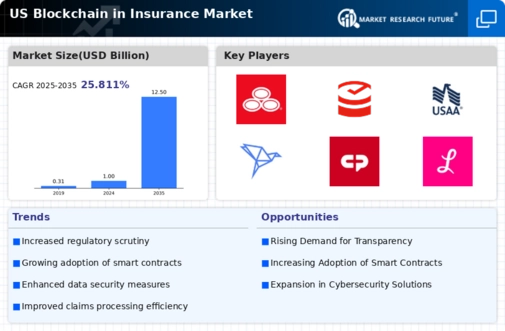The blockchain insurance market is currently characterized by a dynamic competitive landscape, driven by technological advancements and a growing demand for transparency and efficiency in insurance processes. Key players such as AIG (US), Lemonade (US), and Chainlink (US) are at the forefront, each adopting distinct strategies to enhance their market positioning. AIG (US) has focused on integrating blockchain technology to streamline claims processing, thereby improving customer experience and operational efficiency. Meanwhile, Lemonade (US) leverages artificial intelligence and blockchain to offer innovative insurance products, appealing to a tech-savvy demographic. Chainlink (US) is strategically positioned as a provider of decentralized oracles, facilitating smart contracts in insurance, which enhances data reliability and security. Collectively, these strategies contribute to a competitive environment that emphasizes innovation and customer-centric solutions.
In terms of business tactics, companies are increasingly localizing their operations and optimizing supply chains to enhance responsiveness to market demands. The competitive structure of the blockchain insurance market appears moderately fragmented, with several players vying for market share. However, the influence of major companies is significant, as they set industry standards and drive technological advancements that smaller firms often follow.
In October 2025, AIG (US) announced a partnership with a leading blockchain platform to enhance its claims processing capabilities. This strategic move is likely to streamline operations and reduce fraud, thereby increasing customer trust and satisfaction. The integration of blockchain technology into AIG's processes may also lead to cost reductions, positioning the company favorably against its competitors.
In September 2025, Lemonade (US) launched a new product that utilizes blockchain for real-time policy management. This innovation not only enhances user experience but also allows for greater transparency in policy terms and conditions. By adopting such cutting-edge technology, Lemonade (US) reinforces its commitment to disrupting traditional insurance models, potentially attracting a broader customer base.
In August 2025, Chainlink (US) expanded its network of partnerships with various insurance providers to enhance the functionality of its decentralized oracle services. This expansion is crucial as it allows for more robust data integration, which is essential for the effective operation of smart contracts in insurance. By strengthening its ecosystem, Chainlink (US) positions itself as a pivotal player in the blockchain insurance landscape.
As of November 2025, the most pressing trends shaping competition include the increasing digitalization of services, a focus on sustainability, and the integration of artificial intelligence. Strategic alliances among companies are becoming more prevalent, fostering innovation and enhancing service offerings. Looking ahead, competitive differentiation is likely to evolve, shifting from traditional price-based competition to a focus on technological innovation, reliability in supply chains, and enhanced customer experiences. This transition underscores the importance of adaptability and forward-thinking strategies in maintaining a competitive edge.






















Leave a Comment